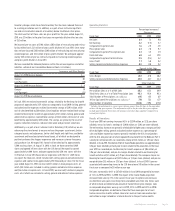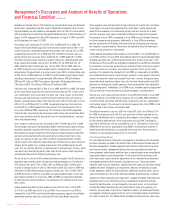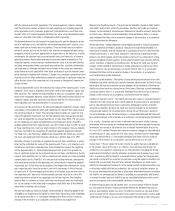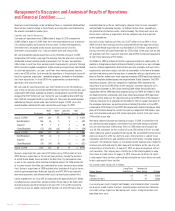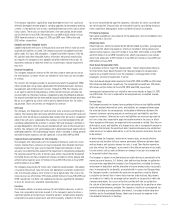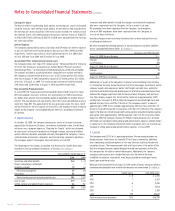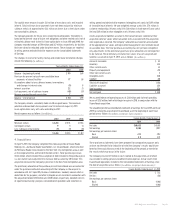Walgreens 2010 Annual Report Download - page 23
Download and view the complete annual report
Please find page 23 of the 2010 Walgreens annual report below. You can navigate through the pages in the report by either clicking on the pages listed below, or by using the keyword search tool below to find specific information within the annual report.both the income and market approaches. The income approach requires manage-
ment to estimate a number of factors for each reporting unit, including projected
future operating results, economic projections, anticipated future cash flows and
discount rates. The market approach estimates fair value using comparable market-
place fair value data from within a comparable industry grouping.
The determination of the fair value of the reporting units and the allocation of that
value to individual assets and liabilities within those reporting units requires us to
make significant estimates and assumptions. These estimates and assumptions
primarily include, but are not limited to: the selection of appropriate peer group
companies; control premiums appropriate for acquisitions in the industries in which
we compete; the discount rate; terminal growth rates; and forecasts of revenue,
operating income, depreciation and amortization and capital expenditures. The
allocation requires several analyses to determine fair value of assets and liabilities
including, among other things, purchased prescription files, customer relationships
and trade names. Although we believe our estimates of fair value are reasonable,
actual financial results could differ from those estimates due to the inherent uncer-
tainty involved in making such estimates. Changes in assumptions concerning future
financial results or other underlying assumptions could have a significant impact on
either the fair value of the reporting units, the amount of the goodwill impairment
charge, or both.
We also compared the sum of the estimated fair values of the reporting units to the
Company’s total value as implied by the market value of the Company’s equity and
debt securities. This comparison indicated that, in total, our assumptions and esti-
mates were reasonable. However, future declines in the overall market value of the
Company’s equity and debt securities may indicate that the fair value of one or
more reporting units has declined below its carrying value.
One measure of the sensitivity of the amount of goodwill impairment charges to key
assumptions is the amount by which each reporting unit “passed” (fair value exceeds
the carrying amount) or “failed” (the carrying amount exceeds fair value) the first
step of the goodwill impairment test. For the reporting units that passed step one,
fair value exceeded the carrying amount by 6% to more than 700%. The fair values
for two reporting units each exceeded their carrying amounts by less than 10%.
Goodwill allocated to these reporting units was $173 million at May 31, 2010. For each
of these reporting units, relatively small changes in the Company’s key assumptions
may have resulted in the recognition of significant goodwill impairment charges.
Our Long Term Care Pharmacy’s goodwill was impaired by $16 million as a result of
the asset sale agreement with Omnicare, which was signed on August 31, 2010.
Generally, changes in estimates of expected future cash flows would have a similar
effect on the estimated fair value of the reporting unit. That is, a 1% change in esti-
mated future cash flows would decrease the estimated fair value of the reporting
unit by approximately 1%. The estimated long-term rate of net sales growth can
have a significant impact on the estimated future cash flows, and therefore, the fair
value of each reporting unit. For the two reporting units whose fair values exceeded
carrying values by less than 10%, a 1% decrease in the long-term net sales growth
rate would have resulted in the reporting units failing the first step of the goodwill
impairment test. Of the other key assumptions that impact the estimated fair values,
most reporting units have the greatest sensitivity to changes in the estimated
discount rate. A 1.0 percentage point increase in estimated discount rates for the
two reporting units whose fair value exceeded carrying value by less than 10%
would also have resulted in the reporting units failing step one. The Company
believes that its estimates of future cash flows and discount rates are reasonable,
but future changes in the underlying assumptions could differ due to the inherent
uncertainty in making such estimates.
We have not made any material changes to the method of evaluating goodwill and
intangible asset impairments during the last three years. Based on current knowledge,
we do not believe there is a reasonable likelihood that there will be a material
change in the estimates or assumptions used to determine impairment.
Allowance for doubtful accounts — The provision for bad debt is based on both specific
receivables and historic write-off percentages. We have not made any material
changes to the method of estimating our allowance for doubtful accounts during the
last three years. Based on current knowledge, we do not believe there is a reason-
able likelihood that there will be a material change in the estimates or assumptions
used to determine the allowance.
Vendor allowances — Vendor allowances are principally received as a result of purchases,
sales or promotion of vendors’ products. Allowances are generally recorded as a
reduction of inventory and are recognized as a reduction of cost of sales when the
related merchandise is sold. Those allowances received for promoting vendors’
products are offset against advertising expense and result in a reduction of selling,
general and administrative expenses to the extent of advertising incurred, with the
excess treated as a reduction of inventory costs. We have not made any material
changes to the method of estimating our vendor allowances during the last three
years. Based on current knowledge, we do not believe there is a reasonable
likelihood that there will be a material change in the estimates or assumptions
used to determine vendor allowances.
Liability for closed locations — The liability is based on the present value of future rent
obligations and other related costs (net of estimated sublease rent) to the first lease
option date. We have not made any material changes to the method of estimating our
liability for closed locations during the last three years. Based on current knowledge,
we do not believe there is a reasonable likelihood that there will be a material
change in the estimates or assumptions used to determine the liability.
Liability for insurance claims — The liability for insurance claims is recorded based on
estimates for claims incurred and is not discounted. The provisions are estimated in
part by considering historical claims experience, demographic factors and other
actuarial assumptions. We have not made any material changes to the method of
estimating our liability for insurance claims during the last three years. Based on
current knowledge, we do not believe there is a reasonable likelihood that there will
be a material change in the estimates or assumptions used to determine the liability.
Cost of sales — Drugstore cost of sales is derived based on point-of-sale scanning
information with an estimate for shrinkage and adjusted based on periodic inventories.
Inventories are valued at the lower of cost or market determined by the last-in,
first-out (LIFO) method. We have not made any material changes to the method of
estimating cost of sales during the last three years. Based on current knowledge,
we do not believe there is a reasonable likelihood that there will be a material
change in the estimates or assumptions used to determine cost of sales.
Income taxes — We are subject to routine income tax audits that occur periodically
in the normal course of business. U.S. federal, state and local and foreign tax
authorities raise questions regarding our tax filing positions, including the timing
and amount of deductions and the allocation of income among various tax jurisdic-
tions. In evaluating the tax benefits associated with our various tax filing positions,
we record a tax benefit for uncertain tax positions using the highest cumulative tax
benefit that is more likely than not to be realized. Adjustments are made to our
liability for unrecognized tax benefits in the period in which we determine the issue
is effectively settled with the tax authorities, the statute of limitations expires for
the return containing the tax position or when more information becomes available.
Our liability for unrecognized tax benefits, including accrued penalties and interest,
is included in other long-term liabilities on our consolidated balance sheets and in
income tax expense in our consolidated statements of earnings.
In determining our provision for income taxes, we use an annual effective income
tax rate based on full-year income, permanent differences between book and tax
income, and statutory income tax rates. The effective income tax rate also reflects
our assessment of the ultimate outcome of tax audits. Discrete events such as audit
settlements or changes in tax laws are recognized in the period in which they occur.
2010 Walgreens Annual Report Page 21










